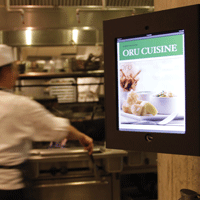Technology is changing the way restaurant operators do business. “With technology becoming increasingly affordable and flexible, there are more opportunities than ever to communicate and engage in dialogue with customers and improve operations,” confirms Susan Senecal, chief marketing officer for A&W Foodservices in Vancouver.
Whether it’s using in-your-face devices such as iPads and smartphones to record orders on the move or less visible innovations such as built-in technologies to make appliances smarter, experts and operators are sharing their thoughts on the top 10 tech trends shaping the industry.
Mobile-enabled marketing
An increasing number of operators are looking to mobile as a means to win customers and build loyalty. Whether it’s promotional, couponing and/or loyalty programs, the message is making its way into customers’ hands. A few intrepid operators are even looking into GPS capabilities to push their marketing message to passers-by. “We’re seeing a massive switch to the increase[d] usage of the Internet on smartphones,” confirms J.P. Martindale, president and co-founder of GuestEngine.com, a marketing and guest-engagement solutions provider in Toronto. “Franchises, especially, are going to more direct methods and providing shorter bits of information that’s more easily digestible to ensure they stay in contact with guests. Family restaurant chains such as Jack Astor’s, Shoeless Joe’s and East Side Mario’s are using text-based marketing to reach customers directly. Special events at large venues are also a prime opportunity.”
Digital displays
While digital menu boards have been on the radar for years, more recently the technology is becoming cheaper and more functional, driving widespread adoption. Operators are using digital content to showcase everything from daily features to back-of-the-house food preparation activities. The Fairmont Pacific Rim is taking the idea even further, using digital screens in the dining rooms to profile local farmers, fishermen and ranchers.
Digital menu boards are being rolled out to select A&W restaurants, too. “It’s a great way to communicate with customers in a more dynamic and flexible way,” says Senecal. “We can modify them for features and promotions for different parts of the day and make things a lot more interesting.”
POS integration
POS systems are becoming all things to all people, with functions that include real-time inventory management, scheduling, surveillance and bookkeeping. The reliability of high-speed networking, combined with processing power, means the capabilities of POS systems keep growing.
Mobile integrated debit and credit is another trend of note, says Jared Gallay, director of Professional Services for Technic POS in Toronto. “Now handheld terminal information can be integrated into your POS, which removes the human-error factor.”
POS on the move
Mobile POS is taking off. “If you’re the type of restaurant where you have order-takers and food runners, such as the foodservice option in the seats at the Air Canada Centre, for example, there are many options in terms of platforms, from tablets to android phones,” Gallay notes. Hardware is equipped with software for order-taking and processing, and information is sent wirelessly to the food production areas for preparation and delivery. Attachments can even be added to iPads for processing credit- and debit-card payments on the spot.
Tablets for everything
With the pervasiveness of iPad apps, tablets are becoming a mainstay at places such as the Fairmont Pacific Rim in Vancouver and Spring Sushi in Hamilton, Ont. They’re being used as POS terminals, to manage kitchen activities (see “Constant Connection” on p. 69) and for tableside services, such as interactive wine lists and order processing.
Self-service kiosks
The kiosk ordering system is cropping up more and more in newer QSR operations. A&W introduced its self-service kiosks in 2010. “It’s all about speed of service and the ability to customize orders. The graphics have improved dramatically as has the availability and capacity of network systems,” Senecal says.
Managing through the cloud
Thanks to secure portals, a growing number of foodservice owners and managers can view operational data from anywhere in the world and from any platform in real time. “Everyone lives in the mobile world now and is asking for it,” Gallay notes.
At Designed Food Systems Inc.’s test kitchen in Ottawa, cloud-based apps are helping the foodservice-planning and design consultants keep its data and software in a safe place. “With the emergence of cloud services from Apple and Google, everything is being stored in the cloud.
It was only a matter of time before it hit the POS world. The reporting is far better and the interface more friendly than other programs,” says Doug Feltmate, president of Designed Food Systems. “And, you’re not going to lose your data.”
Quick-Response (QR) Codes
According to Guest-Engine.com’s Martindale, growth in quick-response (QR) codes is increasing by “hundreds of percentages.” Restaurateurs are looking for these mobile-scanning apps to provide nutritional information on menus, conduct instant surveys and to disseminate interesting facts on the go.
Hero Certified Burgers’ new QR code triggers a survey that customers scan in store to provide instant feedback about their experience. “It all ties back into operations,” says John Lettieri, president and CEO. “It helps us know if our franchisees are doing the right thing. From the idea to implementation; it took two weeks and very little money.”
SAS (software as a service)
With the high cost and complexity of software management, subscription-based Software as a Service (SAS) is gaining traction. So, instead of buying software, operators can “lease” it on a monthly or annual basis and all service and support — including upgrades — is managed by the SAS vendor at its location. “Because you’re paying a monthly fee, it helps you avoid high startup costs and [initial] licensing fees,” Gallay says.
Smart kitchens
Remote refrigeration monitoring, cooking and ventilation as well as automated data capture is gaining popularity in the big-appliance category, Feltmate notes. “If you have an issue, you can easily go online and do a diagnostics rather than having to call a service technician all the time.” Stout Irish Pub in Toronto, for example, has an ice-making system that is proactively monitored by the vendor via satellite.
However, the big technology at the moment is tying temperature monitoring for refrigeration systems into building-automation systems. In time, Feltmate expects to see forward-thinking operators investing in integrated smart-kitchen control systems that can be managed centrally. “Whether it’s a cooker or dishwasher, all the data will go to a single dashboard on your desktop. Electrolux has a fully integrated smart kitchen control system that’s being used in Europe, but it’s not in North America yet.”
Whatever the trend, one thing is certain; the wheel of technology is always turning.





















